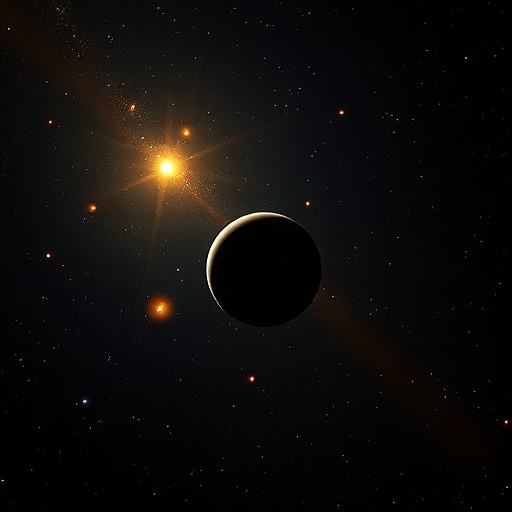Recent astronomical observations have shed new light on the TOI-3884 planetary system, focusing on the intriguing characteristics of TOI-3884b, a super-Neptune-sized exoplanet. This research is groundbreaking as it combines advanced observational techniques and astrophysical modeling to understand the dynamics of exoplanetary systems and their interactions with their host stars. The study utilized the multicolor MuSCAT3 and MuSCAT4 instruments mounted on the Las Cumbres Observatory’s 2-meter telescopes to meticulously capture the spot-crossing transits of TOI-3884b from February to March 2024.
The observations were not merely routine; they aimed to detect specific signals associated with starspots on the red dwarf star TOI-3884. The results revealed clear spot-crossing signals that merited thorough analysis. Light curve analysis indicated the existence of starspots significantly cooler than the star’s surface temperature—specifically about 200 K cooler—which speaks volumes about the physical conditions on the star’s surface. The darker starspots cover roughly 15% of the visible stellar disk, revealing a great deal about both the star’s magnetic activity and the planetary environment.
An intriguing aspect of this research is the discovery of variations in the spot-crossing signals throughout the three identified transits. These changes suggest that the stellar rotation, rather than the evolution of the starspots themselves, predominantly influences the observed variations. Such findings imply a complex interplay between the star’s magnetic field and its surface phenomena, not to mention the gravitational influences exerted by orbiting planets like TOI-3884b.
To confirm their initial findings, the team conducted a comprehensive photometric monitoring campaign employing a global network of LCO 1-meter telescopes. During this extended observational window from December 2024 to March 2025, the researchers gained insights into the periodic brightness fluctuations of the star. These findings led to the determination of an 11.05-day stellar rotation period, a critical parameter for understanding the system’s dynamics.
Moreover, the correlation of this rotation period with the positional shifts observed during the transit observations enabled the team to derive a unique solution for the system’s geometry. Fascinatingly, they found that the axes of the stellar spin and the planet’s orbit are misaligned by about 62 degrees. Such a significant tilt in a planetary system raises compelling questions about the history of the star and its planets. Typically, such tilts are attributed to gravitational interactions with massive companions. However, in the case of TOI-3884, the absence of any known stellar companions makes the system remarkably unique and ripe for further investigation.
This study’s implications extend beyond TOI-3884b itself, offering broader perspectives on the formation and evolution of planetary systems around low-mass stars. The star’s cool starspots and their interaction with the orbiting super-Neptune provide a valuable case for understanding the intricacies of stellar magnetism alongside planetary atmospheres. The sophisticated use of dedicated instrumentation such as MuSCAT3 and MuSCAT4 has paved the way for high-resolution, multi-wavelength observations of exoplanetary transits.
The findings have been accepted for publication in The Astronomical Journal, recognizing the study as a significant contribution to the field of exoplanet research. This meticulous work underscores the importance of combining observational data with theoretical modeling to unravel the complex phenomena prevalent in distant planetary systems. As researchers continue to analyze these observations, there is a potential for new discoveries related to stellar dynamics and planetary atmospheres, expanding our understanding of the universe.
The team’s results set a precedent for future observational strategies in exoplanetary research, particularly regarding systems involving red dwarf stars. The techniques employed can serve as a template for subsequent studies, not only enhancing our grasp of individual systems but also shaping the understanding of planetary formation and the stability of orbits in diverse stellar environments.
In summary, the study of TOI-3884b serves as an illustrative example of the multifaceted nature of exoplanet research. The revelations about stellar rotation, geometrical alignment, and starspot characteristics offer profound insights into the evolutionary pathways of planetary systems and their host stars. As technology advances, the astrophysical community anticipates examining even more complex systems, potentially leading to groundbreaking discoveries in the years to come.
Subject of Research: Not applicable
Article Title: Multiband, Multiepoch Photometry of the Spot-crossing System TOI-3884: Refined System Geometry and Spot Properties
News Publication Date: 8-Sep-2025
Web References: http://dx.doi.org/10.3847/1538-3881/ade2df
References: Not provided
Image Credits: Mayuko Mori, Astrobiology Center
Keywords
Exoplanets, TOI-3884b, Stellar Rotation, Starspots, Astrophysics, Observational Astronomy, Planetary Systems, Multicolor Photometry.




